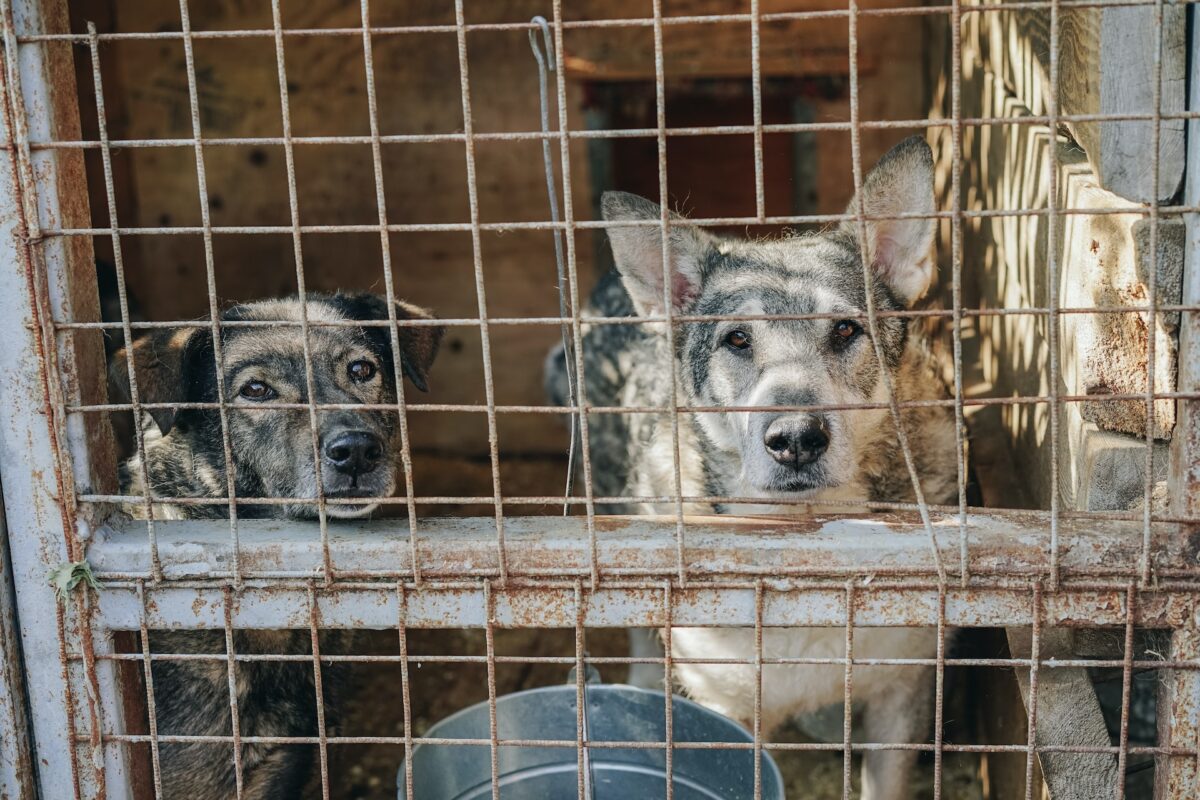Dogs with mange are a common sight in many parts of the world. Mange is a skin condition causing inflammation and secondary bacterial infection. It causes intense itching and discomfort for the affected dog and can spread quickly from dog to dog.

Making an early diagnosis and treatment is essential to prevent the spread of mange; take your furry friend to the doctor for proper diagnosis and treatment if you suspect they have mange. It can present itself in different forms.
The early detection and treatment of mange are crucial to preventing it from spreading and causing further harm to the dog. Prevention includes regular grooming, maintaining a clean and healthy environment, and avoiding close contact with infected animals.
That was a short overview of this awful skin condition; now, let’s zoom in and discuss this in detail. If you need a quick answer, look at the table of contents to go to a specific section section!
Importance of Understanding Mange In Dogs

As a dog owner, it’s crucial to be knowledgeable about mange and its symptoms, causes, and treatment options. Mange can quickly escalate into a severe skin infection if left untreated. Understanding the signs and symptoms of mange can help you seek prompt veterinary care, leading to a faster and more effective recovery for your beloved pet.
If you suspect that your furry friend might have mange, seek the advice of a veterinarian for an accurate diagnosis and appropriate course of treatment.
Understanding the significance of mange is also essential for dog owners to prevent it from spreading to other dogs or animals.
- Identify
If dog owners are familiar with the symptoms of mange, they can promptly detect the condition in their pet and seek veterinary care. This proactive approach can prevent the spread of the disease and minimize the severity of its symptoms.
- Prevention
This can include isolating affected dogs, using appropriate disinfectants, and avoiding close contact with other dogs.
- Effective Treatment
There are several different treatments available for mange, including topical medications, oral medications, and medicated baths. Dog owners who understand the significance of mange can work with their veterinarian to select the most effective treatment for their pet.
- Comfort and Quality of Life
Mange can cause itching, discomfort, and hair loss in affected dogs. Seeking treatment early and providing appropriate care will significantly improve the quality of life for the dog in question.
It is always a good idea for dog owners to be informed about common health conditions that can affect their pets, so they can take proactive steps to ensure their pet’s well-being.
Symptoms of Mange In Dogs
Mange is a skin condition caused by mites, which comes in two main forms: sarcoptic mange and demodectic mange. Although both types share similar symptoms, their severity can differ.
It’s worth noting that other skin conditions can also produce these symptoms, so it’s crucial to seek veterinary attention if you suspect your dog has mange to ensure that they get the correct diagnosis and, consequently, the right treatment. A veterinarian can perform a physical examination, skin scraping, and other tests to confirm the diagnosis.
The following are common symptoms of mange in dogs:
#1 Itchy Skin
One of the primary symptoms of mange in dogs is itchy skin. Dogs with mange will frequently scratch and bite their skin, causing it to become raw and irritated. This persistent itching can lead to secondary skin infections.
#2 Skin Lesions
Dogs with mange may develop skin lesions, which are red, inflamed, and scaly. These lesions may become infected if the dog continues to scratch them.
#3 Bald Patches
In advanced cases of mange, dogs may develop bald patches on their skin. These patches can be caused by excessive scratching, causing hair loss. This leaves the skin exposed and vulnerable to further infections and complications.
#4 Scaly or Crusty Skin
The skin of dogs with mange may appear scaly or crusty and have a foul odor.
#5 Redness or Irritation
Continuous scratching and biting can cause the affected skin to turn red and swell, potentially causing increased discomfort and itching for the dog.
#6 Infections
Sometimes, the skin may become infected, leading to further complications. To prevent the spread of infection, ensure prompt and effective treatment.
#7 Odor
Mange can cause a characteristic musty odor in affected dogs caused by the presence of mites and their waste products.
#8 Loss of Appetite or Depression
In more serious cases, mange can lead to a loss of appetite and even depression in dogs, likely due to the pain and discomfort caused by the condition.
Causes of Mange In Dogs
Understanding the causes of mange is essential in effectively preventing and treating this condition. Some common causes of mange disease in dogs are:
#1 Mites
The primary cause of mange in dogs is mites. These tiny pests can quickly spread from one dog to another through close contact or shared living spaces. Mites can cause severe skin irritation, leading to mange.
#2 Weak Immune System
Dogs with compromised immune systems are more vulnerable to skin infections, including mange. Such susceptibility can stem from factors such as age, genetics, or underlying medical issues that hinder the immune system’s capacity to combat infections.
#3 Hormonal Imbalances
Hormonal imbalances can affect the skin’s natural protective barrier, making dogs more prone to mange. Hormonal imbalances can be due to various factors, including age, genetics, and underlying medical conditions.
#4 Allergies
Dogs with allergies may be more susceptible to mange, as their skin is constantly irritated. Allergies can be due to various factors, including food, environmental allergens, and other irritants.
#5 Stress
Stress can significantly impact dogs’ health, including developing skin problems such as mange. Stress can be due to various factors, including changes in the home environment, lack of socialization, and underlying medical conditions.
#6 Age
Younger dogs are more likely to develop demodectic mange, while older dogs are more susceptible to sarcoptic mange.
#7 Poor Hygiene
Dogs not kept clean and well-groomed are at increased risk of developing mange.
#8 Crowded Living Conditions
Dogs that live in overcrowded conditions, such as those in animal shelters or breeding kennels, are at an increased risk of developing mange.
Different Types of Mange In Dogs

It’s crucial for dog owners to comprehend the various types of mange and their associated symptoms, as it can aid in early detection and prompt veterinary care. Early intervention can prevent the disease from worsening and minimize the possibility of secondary infections.
Sarcoptic mange, caused by mites that burrow into the skin, can provoke intense itching and inflammation. This highly transmissible condition can spread between dogs and humans, and it’s recognizable by symptoms like hair loss, skin lesions, redness, inflammation, and a musty odor. Failure to treat sarcoptic mange can lead to severe symptoms and secondary infections.
Demodectic mange, also known as demodicosis, arises from the overgrowth of the Demodex canis mite, which typically resides in small numbers on healthy dogs’ skin. Dogs with weakened immune systems are susceptible to this type of mange.
Diagnosis Of Mange In Dogs

Diagnosing mange in dogs can be challenging as various diseases have similar symptoms. However, with a thorough examination, your veterinarian can determine if your dog has mange and choose the best course of treatment.
#1 Physical Examination
Your veterinarian will examine your dog’s skin, looking for any signs of redness, itching, hair loss, or scaly patches. They will also check for any signs of secondary skin infections, such as yeast or bacterial infections, which can develop due to scratching and biting caused by mange.
Learn about the importance of Vet visits.
#2 Skin Scraping
A skin scraping is a diagnostic test involving collecting a skin sample from your dog and examining it under a microscope. Your veterinarian will use a scalpel to gently scrape the affected skin area and collect any mites. The skin scraping will reveal if your dog has mange and which type of mites are causing the condition.
#3 Skin Biopsy
In some cases, your veterinarian may recommend a skin biopsy and send it to a laboratory for further analysis. This test can help determine the extent of the damage to your dog’s skin and rule out other potential causes of skin symptoms.
#4 Blood Tests
Blood tests may rule out any underlying health problems contributing to the development of mange. These tests will check the dog’s overall health and determine if any underlying conditions need to be addressed.
#5 Allergy Testing
Allergy testing is performed to determine if the dog has any underlying allergies that may contribute to the mange development. This testing will help the veterinarian determine the best treatment for the dog.
The course of treatment might include medication, topical ointments, shampoos, and alterations to your dog’s diet and surroundings. In severe cases, your veterinarian may advise hospitalization and intensive care.
Treatment of Mange In Dogs:

In general, the following treatments are used to treat mange:
- Medicated Shampoos and Creams: Medicated shampoos and creams are commonly used to treat mild cases of mange. These products contain ingredients that kill the mites and soothe the skin.
- Oral Medications: Oral medications are used to treat more severe cases of mange.
- Antiparasitic medications: These are prescribed to kill the mites causing the mange.
- Antibiotics: A veterinarian and worker typically give these medications by killing the mites from the inside out.
- Topical Treatments: These treatments are directly applied to the skin and can effectively eradicate the mites upon contact.
- Environmental control: To prevent reinfection, your veterinarian may also advise changes to your dog’s environment as part of the treatment.
It’s important to note that mange treatment can be a lengthy and gradual process. It may take several weeks or even months to completely eradicate the mites and alleviate the symptoms of the condition. Some dogs may need multiple treatments to achieve full recovery.
Prevention of Mange In Dogs
Preventing mange is crucial in maintaining your dog’s health and well-being.
Steps to help your dog avoid mange
Keep your dog clean and well-groomed: Bathing and grooming help to keep your dog’s skin healthy and prevent the buildup of bacteria and other irritants that can trigger mange. To avoid the development of mange and other skin conditions in dogs, it’s crucial to use a mild dog shampoo free of harsh chemicals and fragrances.
Maintain a healthy immune system: Additionally, it’s essential to keep your dog’s immune system healthy. Feed your dog a well-balanced diet rich in nutrients, vitamins, and minerals. Ensure they get plenty of exercise to help boost their overall health and well-being.
Avoid close contact with infected dogs: If you come into contact with a dog that has mange, it’s essential to wash your hands thoroughly and avoid close contact with your dog. Mange mites are highly contagious and can quickly spread from dog to dog.
Keep your home and yard clean: Regular cleaning and disinfecting of your home and yard can help to keep mange mites at bay. Vacuum your carpets and furniture regularly and clean any bedding and toys that your dog uses to help prevent the buildup of mites and other irritants.
Use preventive medications: Several medications are available to help prevent mange and keep your dog’s skin healthy.
Visit your veterinarian regularly: Regular check-ups with your veterinarian are a vital part of preventing mange and other skin conditions. Your vet can help identify any underlying health problems and provide advice and treatment options to help keep your dog healthy and happy.
Vaccination: Regular vaccination can help protect your dog from various diseases. Ensuring that their overall health is good will also indirectly lower the risks of them contracting mange.
Reducing stress: Stress in your dog can help prevent skin problems, including mange.
Does Mange In Dogs Affect Humans?
While it may not come as a surprise, mange in dogs can affect humans too! This is because mange mites are contagious, and when people come into contact with them, they are at risk of becoming infected. That being said, the good news is that this occurrence is fairly unusual.
Symptoms may be mild to nonexistent, but contact with infected animals should be avoided nonetheless, as no one likes to experience discomfort or itchiness.
Conclusion

| Key Points |
| As a dog owner, it’s crucial to be knowledgeable about mange as it can quickly escalate into a severe skin infection if left untreated. |
| The primary cause of mange in dogs is mites. These tiny pests can quickly spread from one dog to another through close contact or shared living spaces. |
| Demodectic Mange, also known as demodicosis, arises from the overgrowth of the Demodex canis mite, which typically resides in small numbers on healthy dogs’ skin. |
| Regular check-ups with your veterinarian are a vital part of preventing mange and other skin conditions. |
| Regular grooming, proper hygiene, a healthy diet, and reducing stress are all ways to help avoid mange in dogs. |
By understanding the symptoms, causes, and treatments for mange, you can take the necessary steps to prevent and treat this condition in your furry friend.
Regular grooming, proper hygiene, a healthy diet, and reducing stress are all ways to help avoid mange in dogs. If you suspect your four-legged bestie may have mange, seek veterinary care promptly to ensure prompt and effective recovery. This is crucial not only for your own dog but to ensure that they don’t pass it on to others – remember that it’s extremely contagious!
Thank you for reading this article! If you are curious about other safety-tips related to your beloved four-legged family members, read our post Can Dogs Eat Corn? or Are Snake Plants Toxic To Cats?
Join our Forum for free today!




